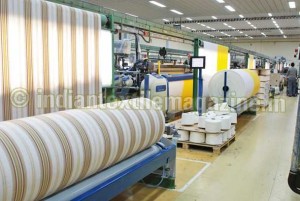Sustainability will be the watchword throughout
The coming decade will witness growing Chinese offshore production, unstoppable e-commerce around the world, rise in demand for  eco-textiles, shift in luxury markets to Asia’s new middle class, and higher prices for everyone in the textile trade and industry.
eco-textiles, shift in luxury markets to Asia’s new middle class, and higher prices for everyone in the textile trade and industry.
These clear predictions emerged at the recent wide-ranging discussion The Textile Magazine had on the global textile trend with the Branch Director of InstitutFrançais de l’Habillement et du Textile (IFTH), the Director of the International Textile Manufacturers Federation (ITMF), and the General Secretary of the European Association for Fashion Retailers (AEDT). Marzoli, the world leader, has surprisingly approved of these predictions stating that there are evidently clear signs of some of them becoming real.
Mr. Jacques Hervé Levy, IFTH Branch Director, said that China’s current hold on the textile production will expand, with its companies outsourcing work overseas. “We don’t know where garments will be produced, but they will be owned and managed by the Chinese industry. If you look at what’s going on in Africa, much of the production is owned by the Chinese industry already.”
 He said that this trend would continue on a small scale into the future as luxury brands try to inject a sense of “responsibility” back into their image. China and emerging markets such as Russia, India and Brazil are expected to become their own sales hotspots for luxury and fashion items in the next decade.
He said that this trend would continue on a small scale into the future as luxury brands try to inject a sense of “responsibility” back into their image. China and emerging markets such as Russia, India and Brazil are expected to become their own sales hotspots for luxury and fashion items in the next decade.
“Increasingly important are those developing countries that are recording high growth rates and where middle and higher classes are growing: China, Brazil, Russia, India, South Africa. These markets are already important, and will be more important in the future,” observed Mr. Christian Schindler, ITMF Director.
The same will be the case with the Middle East where growing economies are going to have high-end products. Costs for all textiles, not just luxury clothing, could also be higher in 10 years and rise even more in the long term as countries such as Vietnam and Bangladesh, some of the last low-cost frontiers on the planet, become more expensive to manufacture in. There is pressure to relocate, but this is not an endless story because costs will start rising and textiles will become more expensive in the mid and long run. Cost-saving opportunities still abound, however, and it will be energy and water saving initiatives that will really cut costs, while meeting consumer demand for sustainability. “We understand and completely share the knowledge about the biggest trend. The big trend that is not going to disappear will be sustainability. The manufacturing industry is certainly focusing on how to reduce energy consumption, reduce waste water and water consumption in general. For example, spinning companies are implementing new energy saving technology and experiencing a reduction in energy costs by 20% to 50%”, added Mr. Schindler.
E-commerce bandwagon
Another cost-saving and business-boosting technology when used well is the internet. Increasing numbers of companies are expected to jump onto the e-commerce bandwagon in the next decade, to take advantage of the growing consumer acceptance of researching and shopping for products online, according to the European Association for Fashion Retailers (AEDT).
Every day more and more companies and brands are taking advantage of social marketing, social networks and e-commerce. This reflects a growing trend that can only become more and more important. New generations and younger consumers are already so used to shopping online or doing research before they go to the physical shops. However, retailers should not expect online shopping to wipe out their street-level stores.
There is a possibility of integrating the traditional shop with an online presentation of products. The potential is there, and the challenge is to find the right strategy in terms of logistics, management of the shop online, IT experts, return on investment, and so on.
Eco-textiles is another important trend, as consumer awareness, company compliance and new environmental legislation come together to promote better environmental and social practices in the future. It shouldn’t be seen just as an obligation but also an opportunity: something good for the sector.
There have been many proposals for legislations and regulations to increase the level of product safety and give more attention to environmental and social concerns. For example, a current European Union proposal concerning biocide use restrictions could affect the technical textile industry within the next 10 years as the legislation is approved and implemented, and the ongoing REACH requirements will continue to cause administrative and logistical challenges for the industry.
Organic textiles
Organic textiles, although part of the eco-textile movement, currently hold less than one per cent of the global cotton market, and are expected to remain a niche market although they will grow to some extent. Genetically modified cotton will definitely be a big research area, however, as scientists come up with stronger, more drought-resistant seeds.
Cotton is a thirsty plant, and with GM cotton there’s a huge potential for water-saving cotton varieties. There is a growing push to consider GM cotton organic because it eliminates the need for pesticides, fertiliser and excessive amounts of water.
Technical textiles are also expected to grow rapidly. Mr. Levy predicted that demand in emerging markets for technical textiles, used in the auto, aero or energy industries, for example, will make it the most rapidly growing sector in the industry.
Functional garments
Functional garments will take a leading role in innovation and research, especially in areas where populations are aging. Especially Western Europe and North America are trying to find solutions to keep their seniors living at home as long as possible, and garments are expected to be part of the solution. They will be monitoring vital data, or have alarms to communicate with emergency members and hospitals.
“These kinds of garments can improve the living conditions of senior citizens, people with disabilities, or those with severe health problems, helping them maintain independence. But at the end of the day – or the decade – the future of the textile industry is still hazy,” opined Mr. Levy.